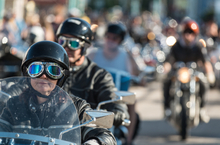

 The wind rushes at your face, carrying dust, dirt and debris. The pickup truck in front of you kicks up gravel as its wheels spin from a start. A bug splatters against your headlight, spraying legs, guts and antennae in your face as you speed through the night. If you’re wearing proper eye protection, these are all minor inconveniences. If your eyes are bare, your sight might be impaired, either temporarily or permanently.
The wind rushes at your face, carrying dust, dirt and debris. The pickup truck in front of you kicks up gravel as its wheels spin from a start. A bug splatters against your headlight, spraying legs, guts and antennae in your face as you speed through the night. If you’re wearing proper eye protection, these are all minor inconveniences. If your eyes are bare, your sight might be impaired, either temporarily or permanently.
Many states require proper eye protection every time you ride on the road. You can check the specific laws in your state and states where you plan to ride on the American Motorcyclist Association website. Even if your state doesn’t require eye protection (my state, California, doesn’t), I strongly advise you to wear some every time you ride.
There are three layers of eye protection available on a bike. I generally use all three when I’m touring.
The first layer is on the bike — a windshield. A properly fitted windshield will direct airflow so that it doesn’t land directly in your face. It can also deflect some of the hard particles that inevitably fly your way, like small rocks, bugs and other debris. Be sure that your windshield is properly constructed from shatterproof material, and that the shield is mounted securely to your front forks or frame.
The second layer of protection is a helmet face shield. I always wear a full-face helmet with an integrated, flip-up shield, and I try to keep the shield closed while my bike is in motion. There are also 3/4-helmets and half-helmets with shields that also offer decent eye protection. Helmet face shields must also be made of shatterproof material. You can choose a tinted or clear face shield, depending on when and where you are going to be riding. If you choose to wear a tinted shield, be sure to carry a clear shield in case of cloudy weather or riding after dark, and learn how to swap shields on your helmet — it’s a tool-free operation on most helmets.
The third layer of protection is goggles or glasses. Goggles are a good choice if you use a half-helmet, because goggles provide additional wind protection around your eyes. Glasses work great behind a full-face shield, as long as your lenses are shatterproof polycarbonate. I use a clear shield and switch back and forth between sunglasses and regular glasses for my third layer of protection (and vision correction).
The latest development in eye protection is the photo-chromatic face shield. Much like Transitions lenses for prescription eyeglasses, the photo-chromatic face shield reacts to changing light conditions while you ride, darkening in bright sunlight and lightening in the shade or dark. Photo-chromatic face shields generally run about $120 — two to three times as much as clear or tinted shields — so there’s a price for convenience. But it might be worth it.
Think about the three layers of eye protection every time you decide to ride, and protect your eyes while you ride your motorcycle.